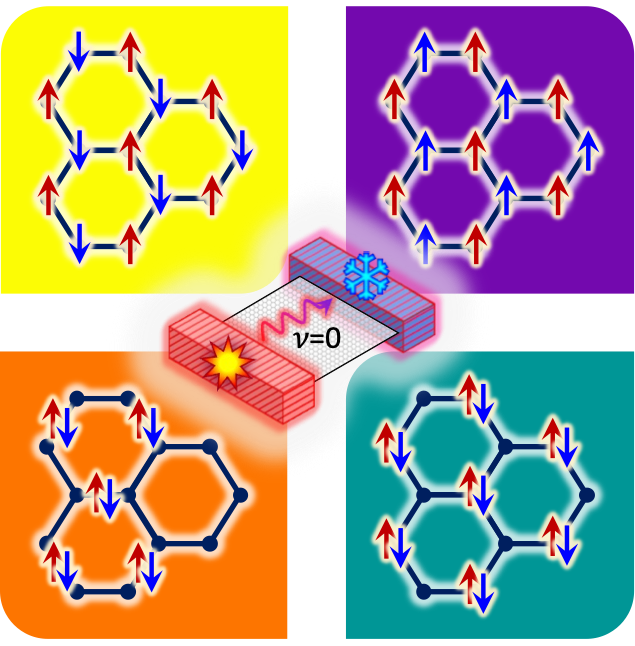L’équipe QUANTIC (LPENS – Mines – INRIA), en collaboration avec la start-up Alice & Bob, a démontré des opérations quantiques sur un qubit très stable : son temps de bit-flip mesuré dépasse les 10 secondes.
Les auteur·ices :
- U. RÉGALADE
- A. BOCQUET
- R. GAUTIER
- J. COHEN
- A. MARQUET
- E. ALBERTINALE
- N. PANKRATOVA
- M.HALLÉN
- F. RAUTSCHKE
- L-A. SELLEM
- P. ROUCHON
- A. SARLETTE
- M. MIRRAHIMI
- P. CAMPAGNE-IBARCQ
- R. LESCANNE
- S. JEZOUIN
- Z. LEGHTAS
Pourquoi est-ce important ?
Les interactions non contrôlées d’un système quantique avec son environnement, connues sous le nom de décohérence, continuent d’induire trop d’erreurs sur les qubits, bloquant ainsi le déploiement de machines quantiques.
Une stratégie prometteuse consiste à construire des qubits qui sont intrinsèquement protégés contre certains types d’erreurs. Ces qubits sont connus sous le nom de « qubits à bruit biaisé ». La promesse fondamentale est que si un qubit est presque parfaitement protégé au niveau matériel contre un type d’erreur (par exemple, les bit-flips), alors l’exigence matérielle pour se protéger contre l’autre type d’erreur (par exemple, les phase-flips) est considérablement moins exigeante.
Cependant, le gain prévu repose sur une condition sévère : les manipulations quantiques du qubit ne doivent pas rompre la protection qui a été si soigneusement conçue au niveau matériel. Si cette condition n’est pas respectée, l’avantage des qubits à bruit biaisé est perdu.
Dans cette expérience, nous avons mis en œuvre un tel qubit, appelé qubit de chat. Il est encodé dans un oscillateur supraconducteur doté d’une dissipation à deux photons. Nous montrons que notre qubit de chat maintient un temps de bit-flip supérieur à dix secondes – une amélioration de 10000 fois par rapport aux mises en œuvre précédentes – tout en contrôlant la phase des états de superposition quantique.
Cette expérience démontre la compatibilité du contrôle quantique et de la protection inhérente contre les bit-flips à un niveau sans précédent, montrant la viabilité des qubits à bruit biaisé pour les futures technologies quantiques.
Comment avons-nous obtenu ce résultat ?
L’implémentation expérimentale du qubit de chat est restée bloquée au niveau de la milliseconde pour les temps de bit-flip. C’est beaucoup plus court que les échelles de temps macroscopiques attendues et nécessaires pour épargner totalement la nécessité d’une protection active contre les bit-flips.
Des preuves croissantes ont incriminé le circuit de sondage : un qubit Transmon, pour avoir rompu la protection contre les bit-flips. Retirer ou remplacer le Transmon était un défi de taille car cela nécessitait d’inventer un nouveau protocole de tomographie quantique.
C’est précisément ce qui a été réalisé dans cette expérience. En effet, notre protocole sans Transmon ne nécessite aucun élément de circuit supplémentaire. Au lieu de cela, il exploite la non-linéarité déjà présente dans le qubit de chat pour mesurer les observables quantiques.
Cela nous a conduit à une amélioration de quatre ordres de grandeur des temps de bit-flip, établissant une limite ultra-basse (centaines de milliHertz) sur le taux de bit-flip induit par le contrôle cohérent du qubit.
Notre qubit – le qubit de chat – est encodé dans un oscillateur supraconducteur. Les deux états du qubit sont des états cohérents de même nombre de photons et de phases opposées. La colonne de gauche affiche les fonctions de Wigner mesurées de l’état de superposition quantique pour des nombres de photons croissants. La colonne du milieu affiche les oscillations quantiques mesurées de la phase de ces superpositions, démontrant ainsi notre capacité à contrôler l’état quantique de notre qubit. Enfin, la colonne de droite démontre la stabilité exceptionnelle de notre qubit de chat : son temps de bit-flip dépasse 10 secondes pour les états de plus grand nombre de photons.













